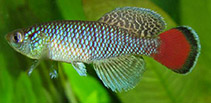| Family: |
Nothobranchiidae (African rivulines) |
| Max. size: |
6 cm TL (male/unsexed) |
| Environment: |
benthopelagic; freshwater, non-migratory |
| Distribution: |
Africa: lower Tana and Sabaki river drainages in eastern Kenya and Juba river drainage in southern Somalia (Ref. 27139). Reported from the Wabi Shebele basin in Ethiopia (Ref. 58460). |
| Diagnosis: |
|
| Biology: |
It occurs in temporary pools, swamps and ditches or rain pans, usually without connection to river courses (Ref. 30558). The adults die when waterbodies dry out with low rainfall (Ref. 30558). Males display to attract ripe females, pair off and spawn, grasping the female by folding over the large dorsal and anal fins (Ref. 30558). Spawning occurs daily for an extended period with a few eggs laid at a time (Ref. 30558). It is a bottom spawner (Ref. 27139, Ref. 30558) and development is suspended when the water bodies dry out (Ref. 30558). The eggs hatch the following rainy season when the pan fills, the fish growing to maturity in a few weeks (Ref. 30558). It are aggressive predators on insects and other aquatic invertebrates (Ref. 30558); therefore it is used for mosquito larva control (Ref. 30558). It is easy to maintain in the aquarium (Ref. 27139) and thus a popular aquarium fish (Ref. 30558). |
| IUCN Red List Status: |
Least Concern (LC); Date assessed: 09 December 2018 Ref. (130435)
|
| Threat to humans: |
harmless |
| Country info: |
|
Source and more info: www.fishbase.org. For personal, classroom, and other internal use only. Not for publication.

